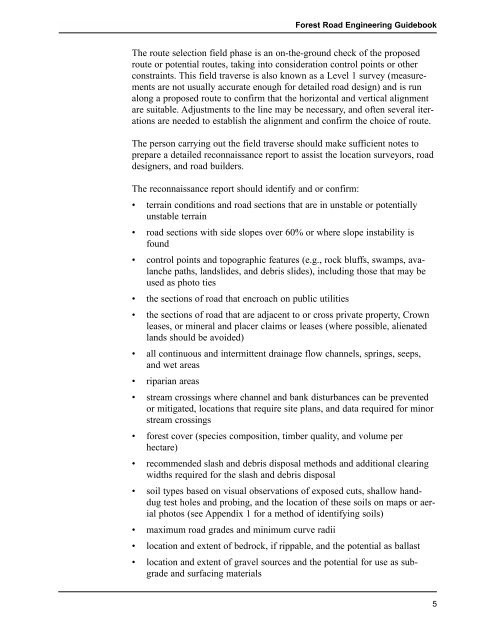Forest Road Engineering Guidebook - Ministry of Forests
Forest Road Engineering Guidebook - Ministry of Forests
Forest Road Engineering Guidebook - Ministry of Forests
Create successful ePaper yourself
Turn your PDF publications into a flip-book with our unique Google optimized e-Paper software.
<strong>Forest</strong> <strong>Road</strong> <strong>Engineering</strong> <strong>Guidebook</strong><br />
The route selection field phase is an on-the-ground check <strong>of</strong> the proposed<br />
route or potential routes, taking into consideration control points or other<br />
constraints. This field traverse is also known as a Level 1 survey (measurements<br />
are not usually accurate enough for detailed road design) and is run<br />
along a proposed route to confirm that the horizontal and vertical alignment<br />
are suitable. Adjustments to the line may be necessary, and <strong>of</strong>ten several iterations<br />
are needed to establish the alignment and confirm the choice <strong>of</strong> route.<br />
The person carrying out the field traverse should make sufficient notes to<br />
prepare a detailed reconnaissance report to assist the location surveyors, road<br />
designers, and road builders.<br />
The reconnaissance report should identify and or confirm:<br />
• terrain conditions and road sections that are in unstable or potentially<br />
unstable terrain<br />
• road sections with side slopes over 60% or where slope instability is<br />
found<br />
• control points and topographic features (e.g., rock bluffs, swamps, avalanche<br />
paths, landslides, and debris slides), including those that may be<br />
used as photo ties<br />
• the sections <strong>of</strong> road that encroach on public utilities<br />
• the sections <strong>of</strong> road that are adjacent to or cross private property, Crown<br />
leases, or mineral and placer claims or leases (where possible, alienated<br />
lands should be avoided)<br />
• all continuous and intermittent drainage flow channels, springs, seeps,<br />
and wet areas<br />
• riparian areas<br />
• stream crossings where channel and bank disturbances can be prevented<br />
or mitigated, locations that require site plans, and data required for minor<br />
stream crossings<br />
• forest cover (species composition, timber quality, and volume per<br />
hectare)<br />
• recommended slash and debris disposal methods and additional clearing<br />
widths required for the slash and debris disposal<br />
• soil types based on visual observations <strong>of</strong> exposed cuts, shallow handdug<br />
test holes and probing, and the location <strong>of</strong> these soils on maps or aerial<br />
photos (see Appendix 1 for a method <strong>of</strong> identifying soils)<br />
• maximum road grades and minimum curve radii<br />
• location and extent <strong>of</strong> bedrock, if rippable, and the potential as ballast<br />
• location and extent <strong>of</strong> gravel sources and the potential for use as subgrade<br />
and surfacing materials<br />
5

















